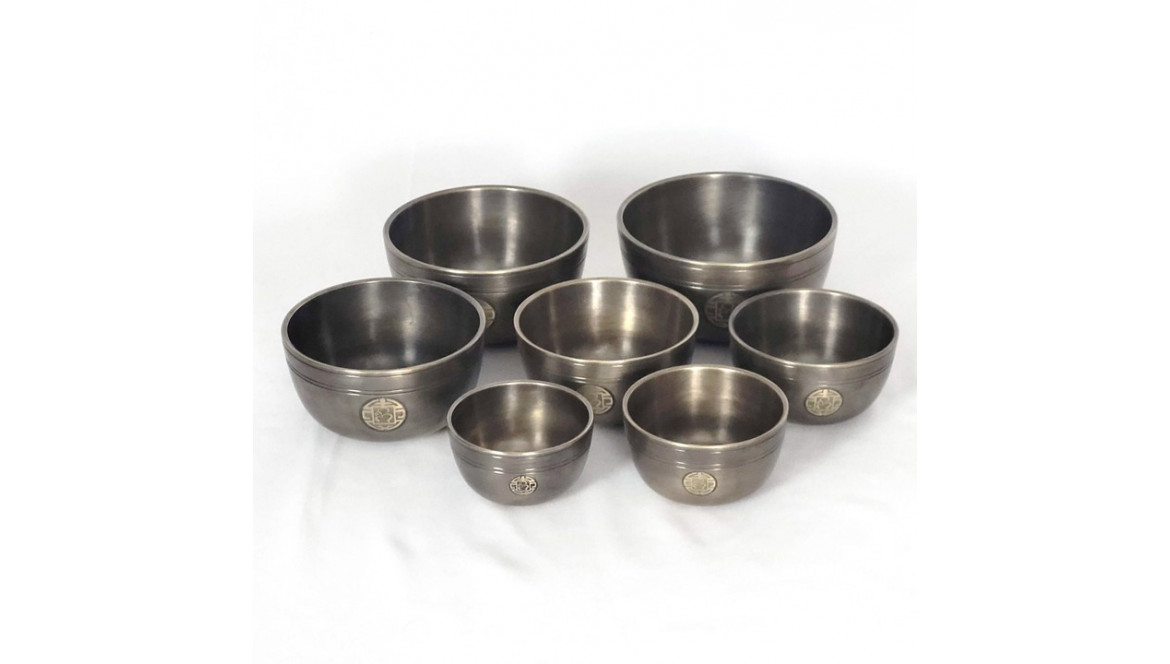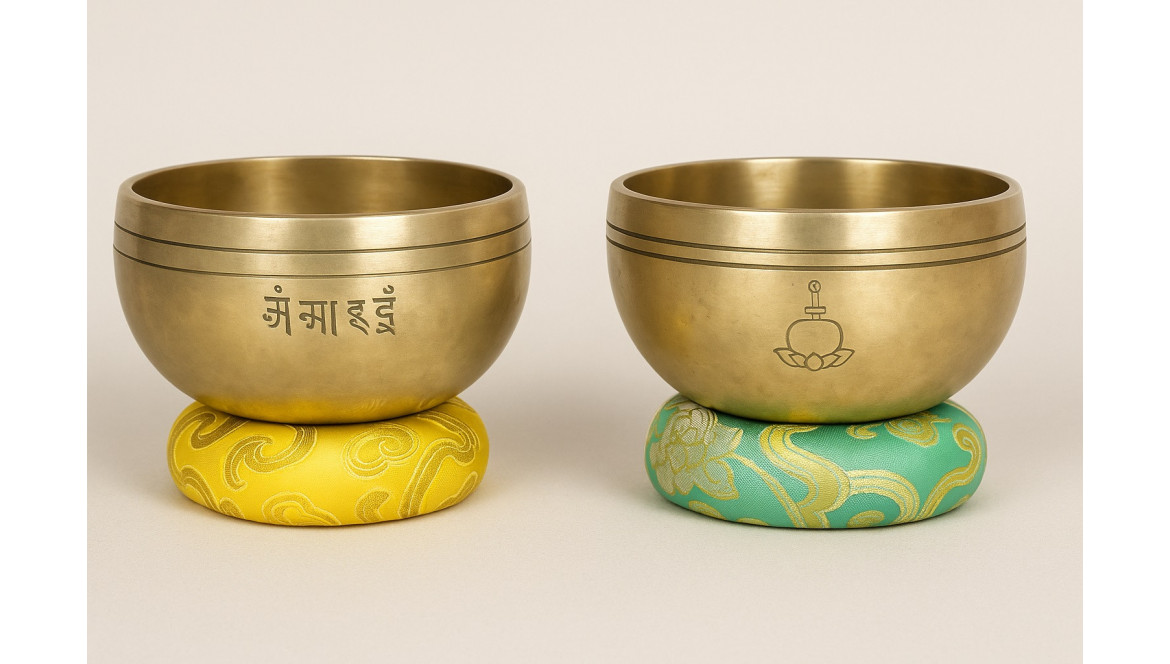ความลับเบื้องหลังจักระทั้ง 7 และการสร้างสมดุลให้กับพวกมัน

สำรวจจักระทั้งเจ็ด ตำแหน่ง องค์ประกอบ และความถี่ที่เกี่ยวข้อง เรียนรู้ว่าการบำบัดด้วยเสียงโดยใช้ชามร้องและติงชาของทิเบตสามารถช่วยปรับสมดุลพลังงาน ส่งเสริมความเป็นอยู่ที่ดี และฟื้นฟูความสมดุลในร่างกายและจิตใจได้อย่างไร
บทนำ
แนวคิดเรื่องจักระ (chakras) ถูกกล่าวถึงในหนังสือศาสนาและคัมภีร์เก่าแก่ที่สุดของศาสนาฮินดูและพุทธศาสนา จักระถือเป็นจุดศูนย์กลางพลังงานของร่างกาย ในการฝึกโยคะและอายุรเวทหลายรูปแบบ จักระถูกเชื่อว่าเป็นปัจจัยสำคัญที่สุดในการมีสุขภาพกายและใจที่ดี หนังสือแทนตระศตวรรษที่ 16 ชื่อ Shat Chakra Nirupana โดย Puranand Swami กล่าวถึงตำแหน่งของจักระทั้ง 7 ทั้งหมด พร้อมทั้งสิ่งที่เกี่ยวข้องและวิธีการปรับสมดุล คัมภีร์ Atharva Veda ซึ่งเป็นหนึ่งในหนังสือที่เก่าแก่และศักดิ์สิทธิ์ที่สุดของชาวฮินดู กล่าวถึงร่างกายว่าเป็นสถานที่ของพลังงานและจิตสำนึก แนวคิดนี้เป็นรากฐานของโยคะและแทนตระ ซึ่งอิงตามจักระและจุดพลังงานในร่างกายมนุษย์ หลายคัมภีร์ทางพุทธศาสนาก็กล่าวถึงการมีอยู่ของจักระเช่นกัน Hevajra Tantra ซึ่งประพันธ์ระหว่างศตวรรษที่ 8 ถึง 10 อธิบายระบบร่างกายละเอียดรวมถึงช่องทางพลังงาน (nadis) และจักระ Kalachakra Tantra ซึ่งเป็นหนังสือขั้นสูงในพุทธศาสนาติเบต อธิบายจักรวาลวิทยาและระบบศูนย์พลังงานภายในร่างกาย แม้ว่าการปฏิบัติทางศาสนาจะแตกต่างกัน แต่จุดร่วมคือเชื่อว่าร่างกายมีระบบพลังงานและจักระเช่นเดียวกัน บทความนี้จะกล่าวอย่างละเอียดว่าจักระคืออะไร อยู่ที่ไหน สิ่งใดเกี่ยวข้อง และความถี่ใดสอดคล้องกับจักระแต่ละจุด
จักระราก (Root Chakra - Muladhara):
จักระรากตั้งอยู่ที่ปลายไขสันหลังหรือฐานของกระดูกสันหลัง ธาตุของจักระรากคือดิน สีที่เกี่ยวข้องคือสีแดง จักระรากเกี่ยวข้องกับความมั่นคงและความปลอดภัย เมื่อจักระรากไม่สมดุลหรือพลังงานไม่สมดุล อาจเผชิญกับความกลัว ความไม่มั่นคง ความไม่มั่นคงทางการเงิน และปัญหาทางกายภาพที่ขา เท้า หรือหลังส่วนล่าง เครื่องดนตรีเช่น ชามร้องเพลงทิเบต ที่ปรับความถี่เป็น C มักใช้ในการบำบัดด้วยเสียงเพื่อคืนสมดุลให้จักระนี้ ผู้ปฏิบัติอาจใช้ ติ้งชา ซึ่งส่งเสียงสูงชัดเจน เพื่อชำระและปรับพลังงานในบริเวณนี้
จักระสะโพก (Sacral Chakra - Svadhisthana):
จักระสะโพก หรือ Svadhisthana ตั้งอยู่บริเวณท้องน้อย ประมาณ 5 เซนติเมตรใต้สะดือ ธาตุของจักระสะโพกคือ น้ำ จักระนี้เกี่ยวข้องกับความคิดสร้างสรรค์ ความสุข สุขภาพทางเพศและอารมณ์ โดยพื้นฐานเกี่ยวข้องกับความหลงใหลและความลื่นไหลในชีวิต หากมีปัญหากับจักระสะโพก อาจพบปัญหาขาดความคิดสร้างสรรค์ อารมณ์ไม่มั่นคง ปัญหาทางเพศ หรือแม้แต่ความรู้สึกผิด ชามทิเบต ปรับความถี่ D ถูกใช้ในแนวทางการบำบัดเพื่อช่วยคืนสมดุล การบำบัดด้วยเสียงร่วมกับการทำสมาธิอย่างมีแนวทางมีประสิทธิภาพเป็นพิเศษในการสร้างความมั่นคงให้จักระสะโพก
จักระสุริยะนวล (Solar Plexus Chakra - Manipura):
จักระสุริยะนวลตั้งอยู่เหนือสะดือ บริเวณช่องท้องส่วนบน ธาตุของจักระนี้คือไฟ จักระนี้เกี่ยวข้องกับพลัง ความมั่นใจ และความเคารพในตนเอง ควบคุมพลังส่วนบุคคล ระบบเผาผลาญ และระบบย่อยอาหาร การไม่สมดุลอาจนำไปสู่ปัญหาเช่น ความเคารพตนเองต่ำ ปัญหาการย่อยอาหาร หรือปัญหาที่เกี่ยวข้องกับความโกรธและการควบคุม ชามร้องเพลง ที่สั่นสะเทือนด้วยความถี่ E มักใช้ในการบำบัดด้วยเสียงเพื่อปรับสมดุลจักระนี้ ฟื้นฟูความรู้สึกถึงอำนาจและความยืดหยุ่นทางอารมณ์
จักระหัวใจ (Heart Chakra - Anahata):
จักระหัวใจตั้งอยู่ตรงกลางหน้าอก ระดับหัวใจ ธาตุของจักระหัวใจคืออากาศ จักระหัวใจควบคุมความรัก ความเมตตา และการบำบัดอารมณ์ ควบคุมความสามารถในการรักโดยไม่มีเงื่อนไขและความสามารถในการเข้าใจผู้อื่น ปัญหาเช่น โรคหัวใจ ชาอารมณ์ และความยากลำบากในความสัมพันธ์อาจบ่งบอกถึงความไม่สมดุลของจักระหัวใจ ในการบำบัดด้วยเสียง ชามร้องเพลงทิเบตปรับความถี่ F ใช้เพื่อเปิดจักระหัวใจและส่งเสริมสุขภาพอารมณ์ ติ้งชา ก็มีประสิทธิภาพในการล้างการอุดตันในศูนย์พลังงานนี้
จักระคอ (Throat Chakra - Vishuddha):
จักระคอ หรือ Vishuddha ตั้งอยู่บริเวณลำคอ ธาตุของจักระคอคือเอเทอร์ (เสียง) จักระคอควบคุมการสื่อสาร การแสดงออก และความคิดสร้างสรรค์ เกี่ยวข้องกับความสามารถในการแสดงตัวเองด้วยวาจาและความคิดสร้างสรรค์ การอุดตันที่นี่อาจทำให้เกิดปัญหาการสื่อสาร ปัญหาต่อมไทรอยด์ และความยากลำบากในการพูดความจริงต่อตนเอง ชามทิเบต และติ้งชา ที่สั่นสะเทือนด้วยความถี่ G มักใช้ในการบำบัดด้วยเสียงเพื่อเคลียร์การอุดตันและปรับปรุงการแสดงออกของตนเอง
จักระตาที่สาม (Third Eye Chakra - Ajna):
จักระตาที่สามตั้งอยู่บนหน้าผาก ระหว่างคิ้ว ธาตุคือแสง (จิตใจ) จักระนี้เกี่ยวข้องกับสัญชาตญาณ การมองการณ์ไกล และปัญญา เกี่ยวข้องกับวิสัยทัศน์ภายใน ความสามารถพิเศษทางจิต และความเข้าใจเหนือการรับรู้ปกติ การอุดตันของจุดพลังงานนี้อาจทำให้ขาดความชัดเจน ขาดสมาธิ และตัดสินใจยาก ชามร้องเพลง ปรับความถี่ A มักใช้เพื่อเพิ่มสัญชาตญาณและการรับรู้ ทำให้จักระนี้ชัดเจนและสมดุล
จักระมงกุฎ (Crown Chakra - Sahasrara):
จักระมงกุฎตั้งอยู่บนศีรษะ ธาตุคือพลังงานจิตวิญญาณ (การเชื่อมต่อกับจักรวาล) จักระมงกุฎเกี่ยวข้องกับการเชื่อมต่อกับสิ่งศักดิ์สิทธิ์ จิตสำนึกสูง และการตรัสรู้ เชื่อว่าการมีจักระนี้อยู่ในสภาพที่ถูกต้องหรือเปิดจักระนี้จะปลดล็อกความลับของจักรวาลและช่วยให้เข้าใจชีวิตอย่างลึกซึ้ง ชามร้องเพลง และ ชามทิเบต ปรับความถี่ B มักใช้ในการบำบัดด้วยเสียงเพื่อให้เกิดการตื่นรู้ทางจิตวิญญาณและความเป็นหนึ่งเดียวกับจักรวาล ติ้งชา ยังใช้เพื่อสร้างพื้นที่สั่นสะเทือนบริสุทธิ์ ช่วยในการทำสมาธิและการบำบัด
มีเทคนิคหลายอย่างที่แนะนำเพื่อปรับสมดุลจักระ เทคนิคหนึ่งคือการบำบัดด้วยเสียง ใช้ความถี่เฉพาะในการปรับสมดุลจักระ เพื่อลบการอุดตันและฟื้นฟูความสมดุลในจุดนั้น ผู้ปฏิบัติ เช่น Santa Ratna Shakya Sajan Thapaliya และ Kalyan Tamrakar ซึ่งเป็นผู้เชี่ยวชาญจากเนปาล ใช้อุปกรณ์บำบัดด้วยเสียง เช่น ชามทิเบต ชามร้องเพลง และติ้งชา ปรับความถี่ให้ตรงกับจักระแต่ละจุด ปกติจะใช้ ชุดชามร้องเพลง 7 ใบ โดยแต่ละใบตรงกับจักระเฉพาะจุด ช่วยเคลียร์การอุดตัน พลังงานที่ลึกและสมดุลสามารถเกิดขึ้นได้ด้วยเทคนิคการทำสมาธิที่เน้นจักระแต่ละจุด การรักษาสมดุลของจักระยังสามารถสนับสนุนด้วยการปรับเปลี่ยนอาหารและวิถีชีวิต เพื่อรักษาพลังและสุขภาพของจักระแต่ละจุด ดังนั้น การปฏิบัติตามแนวทางเหล่านี้จะช่วยให้มีชีวิตที่สอดคล้องและสมดุลทั้งร่างกาย จิตใจ และจิตวิญญาณ









Comments
No comment at this time!
Leave your comment